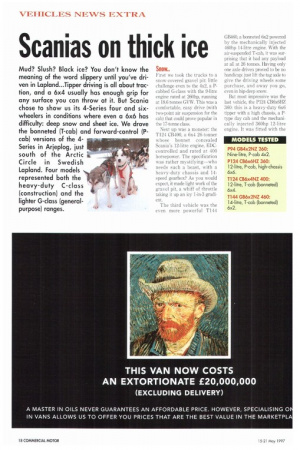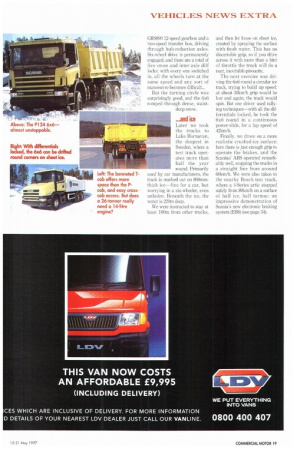Scanias on thick ice
Page 20

Page 21

If you've noticed an error in this article please click here to report it so we can fix it.
Mud? Slush? Black ice? You don't know the meaning of the word slippery until you've driven in Lapland...Tipper driving is all about traction, and a 6x4 usually has enough grip for any surface you can throw at it. But Scania chose to show us its 4-Series four and sixwheelers in conditions where even a 6x6 has difficulty: deep snow and sheet ice. We drove the bonneted (T-cab) and forward-control (Pcab) versions of the 4Series in Arjeplog, just south of the Arctic Circle in Swedish Lapland. Four models represented both the
heavy-duty C-class ,
(construction) and the 41,
lighter G-class (generalpurpose) ranges.
Snow..
First we took the trucks to a snow-covered gravel pit: little challenge even to the 4x2, a Pcabbed G-class with the 9-litre engine rated at 260hp, running at 18.6 tonnes GVW. This was a comfortable, easy drive {with two-point air suspension for the cab) that could prove popular in the 17-tonne class.
Next up was a monster: the 1124 CB400, a 6x4 26-tonner whose bonnet concealed Scania's 12-litre engine, EDCcontrolled and rated at 400 horsepower. The specification was rather mystifying—who needs such a beast, with a heavy-duty chassis and 14speed gearbox? As you would expect, it made light work of the gravel pit, a whiff of throttle taking it up an icy 1-in-3 gradient.
The third vehicle was the even more powerful T144 GB460, a bonneted 6x2 powered by the mechanically injected 460hp 14-litre engine. With the air-suspended T-cab, it was surprising that it had any payload at all at 26 tonnes. Having only one axle driven proved to be no handicap: just lift the tag axle to give the driving wheels some purchase, and away you go, even in hip-deep snow.
But most impressive was the last vehicle, the P124 CB6x6HZ 360: this is a heavy-duty 6x6 tipper with a high chassis, a type day day cab and the mechanically injected 360hp 12-litre engine. It was fitted with the GRS890 12-speed gearbox and a two-speed transfer box, driving through hub-reduction axles. Six-wheel drive is permanently engaged, and there are a total of five cross and inter-axle diff locks: with every one switched in, all the wheels turn at the same speed and any sort of manoeuvre becomes difficult...
But the turning circle was surprisingly good, and the 6x6 romped through dense, waistdeep snow.
...and ice
Later we took the trucks to Lake Homavan, the deepest in Sweden, where a test track operates more than half the year round. Primarily used by car manufacturers, the track is marked out on 800mmthick ice—fine for a car, but worrying in a six-wheeler, even unladen. Beneath the ice, the water is 220m deep.
We were instructed to sray at least 100m from other trucks, and then let loose on sheet ice, created by spraying the surface with fresh water. This has no discernible grip, so if you drive across it with more than a hint of throttle the truck will do a neat, inevitable pirouette.
The next exercise was driving the 6x6 round a circular ice track, trying to build up speed: at about 36krnth grip would be lost and again, the truck would spin. But one driver used rallying techniques—with all the differentials locked, he took the 6x6 round in a continuous power-slide, for a lap speed of 42km/h.
Finally, we drove on a more realistic crushed-ice surface: here there is just enough grip to operate the brakes, and the Scanias' ABS operated remarkably well, stopping the trucks in a straight line from around 60km/h. We were also taken to the nearby Bosch test track, where a 4-Series attic stopped safely from 80km/h on a surface of half ice, half tarmac: an impressive demonstration of Scania's new electronic braking system (EBS) (see page 34).
































































































































